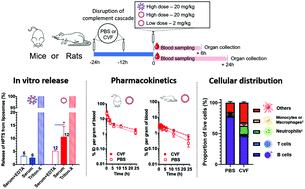Our official English website, www.x-mol.net, welcomes your
feedback! (Note: you will need to create a separate account there.)
Role of the complement cascade in the biological fate of liposomes in rodents.
Nanoscale ( IF 5.8 ) Pub Date : 2020-08-25 , DOI: 10.1039/d0nr04100a Iara Maíra de Oliveira Viana 1 , Philippe Grenier , Joan Defrêne , Frédéric Barabé , Eliana Martins Lima , Nicolas Bertrand
Nanoscale ( IF 5.8 ) Pub Date : 2020-08-25 , DOI: 10.1039/d0nr04100a Iara Maíra de Oliveira Viana 1 , Philippe Grenier , Joan Defrêne , Frédéric Barabé , Eliana Martins Lima , Nicolas Bertrand
Affiliation

|
Nanomedicines, including liposomes, have been used to improve the clinical efficacy and safety of drugs. In some liposomal formulations, a hydrophilic polymer coating of poly(ethylene glycol) (PEG) is used to increase the circulation time. Understanding the biological mechanisms responsible for the clearance of PEGylated and non-PEGylated nanomedicines is necessary to develop better-performing materials. The purpose of this work is to explore the role of complement in the elimination of intravenously administered liposomes (PEGylated and non-PEGylated) in mice and rats. Here, the complement cascade was depleted by intraperitoneal injections of cobra venom factor (CVF) 12 and 24 hours before the intravenous injection of radiolabeled liposomes. In both mice and rats, non-PEGylated liposomes showed faster elimination than PEGylated liposomes. At a lipid dose of 20 mg kg−1, the abrogation of the complement cascade (in CVF group) did not alter the circulation time of either PEGylated or non-PEGylated liposomes. In contrast, at lower doses (2 mg kg−1), animals treated with CVF had slightly higher levels of circulating liposomes, especially during the 24 hours pharmacokinetic studies. The complement cascade seems to govern the uptake of non-PEGylated liposomes by splenic B cells. Altogether, these results suggest that although PEGylated and non-PEGylated liposomes can activate complement, the impact of this cascade on their circulation time is minor and mostly perceivable at later phases of distribution. This work enlightens biological pathways responsible for in vivo clearance of liposomes and will help in orienting future research in elucidating the nano-bio interface.
中文翻译:

补体级联在啮齿动物脂质体的生物命运中的作用。
包括脂质体在内的纳米药物已被用于改善药物的临床疗效和安全性。在一些脂质体制剂中,聚(乙二醇)(PEG)的亲水性聚合物涂层用于增加循环时间。了解负责清除聚乙二醇化和非聚乙二醇化纳米药物的生物学机制对于开发性能更好的材料是必要的。这项工作的目的是探讨补体在消除小鼠和大鼠静脉内施用的脂质体(聚乙二醇化和非聚乙二醇化)中的作用。在这里,在静脉内注射放射性标记脂质体之前的12和24小时内,通过腹膜内注射眼镜蛇毒因子(CVF)消除了补体级联反应。在小鼠和大鼠中,非PEG化脂质体均显示出比PEG化脂质体更快的消除。-1,补体级联的废除(在CVF组中)不改变PEG化或非PEG化脂质体的循环时间。相反,在较低剂量(2 mg kg -1)下,用CVF治疗的动物的循环脂质体水平略高,尤其是在24小时药代动力学研究期间。补体级联似乎控制脾B细胞对非PEG化脂质体的摄取。总而言之,这些结果表明,尽管聚乙二醇化和非聚乙二醇化的脂质体可以激活补体,但是这种级联对其脂质体循环时间的影响很小,并且在分布的后期几乎可以察觉。这项工作启发了体内的生物学途径 脂质体的清除,将有助于指导未来研究阐明纳米生物界面。
更新日期:2020-09-24
中文翻译:

补体级联在啮齿动物脂质体的生物命运中的作用。
包括脂质体在内的纳米药物已被用于改善药物的临床疗效和安全性。在一些脂质体制剂中,聚(乙二醇)(PEG)的亲水性聚合物涂层用于增加循环时间。了解负责清除聚乙二醇化和非聚乙二醇化纳米药物的生物学机制对于开发性能更好的材料是必要的。这项工作的目的是探讨补体在消除小鼠和大鼠静脉内施用的脂质体(聚乙二醇化和非聚乙二醇化)中的作用。在这里,在静脉内注射放射性标记脂质体之前的12和24小时内,通过腹膜内注射眼镜蛇毒因子(CVF)消除了补体级联反应。在小鼠和大鼠中,非PEG化脂质体均显示出比PEG化脂质体更快的消除。-1,补体级联的废除(在CVF组中)不改变PEG化或非PEG化脂质体的循环时间。相反,在较低剂量(2 mg kg -1)下,用CVF治疗的动物的循环脂质体水平略高,尤其是在24小时药代动力学研究期间。补体级联似乎控制脾B细胞对非PEG化脂质体的摄取。总而言之,这些结果表明,尽管聚乙二醇化和非聚乙二醇化的脂质体可以激活补体,但是这种级联对其脂质体循环时间的影响很小,并且在分布的后期几乎可以察觉。这项工作启发了体内的生物学途径 脂质体的清除,将有助于指导未来研究阐明纳米生物界面。











































 京公网安备 11010802027423号
京公网安备 11010802027423号